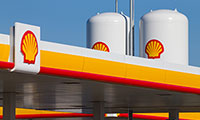Disclaimer
These web pages give information and data taken from the Royal Dutch Shell plc Annual Report and Form 20-F 2017. They do not constitute the official version of the document filed with relevant authorities.
The Royal Dutch Shell plc Annual Report and Form 20-F (this Report) serves as the Annual Report and Accounts in accordance with UK requirements and as the Annual Report on Form 20-F as filed with the US Securities and Exchange Commission (SEC) for the year ended December 31, 2017, for Royal Dutch Shell plc (the Company) and its subsidiaries (collectively referred to as Shell). This Report presents the Consolidated Financial Statements of Shell (pages 137–178), the Parent Company Financial Statements of Shell (pages 199–207) and the Financial Statements of the Royal Dutch Shell Dividend Access Trust (pages 213–216). Cross references to Form 20-F are set out on pages 02–03 of this Report.
Financial reporting terms used in this Report are in accordance with International Financial Reporting Standards (IFRS). The Consolidated Financial Statements comprise the financial statements of the Company and its subsidiaries. “Subsidiaries” and “Shell subsidiaries” refer to those entities over which the Company has control, either directly or indirectly. Entities and unincorporated arrangements over which Shell has joint control are generally referred to as “joint ventures” and “joint operations” respectively, and entities over which Shell has significant influence but neither control nor joint control are referred to as “associates”. “Joint ventures” and “joint operations” are collectively referred to as “joint arrangements”.
In addition to the term “Shell”, in this Report “we”, “us” and “our” are also used to refer to the Company and its subsidiaries in general or to those who work for them. These terms are also used where no useful purpose is served by identifying the particular entity or entities. The term “Shell interest” is used for convenience to indicate the direct and/or indirect ownership interest held by Shell in an entity or unincorporated joint arrangement. The companies in which Royal Dutch Shell plc has a direct or indirect interest are separate legal entities. Shell subsidiaries’ data include their interests in joint operations.
We also refer to “Shell’s net carbon footprint” in this Report. This includes Shell’s carbon emissions from the production of our energy products, our suppliers’ carbon emissions in supplying energy for that production, and our customers’ carbon emissions associated with their use of the energy products we sell. Shell only controls its own emissions but, to support society in achieving the Paris Agreement goals, we aim to help and influence such suppliers and consumers to likewise lower theirs. The use of the terminology “Shell’s net carbon footprint” is for convenience only and not intended to suggest these emissions are those of Shell or its subsidiaries.
Except where indicated, the figures shown in the tables in this Report are in respect of subsidiaries only, without deduction of any non-controlling interest. However, the term “Shell share” is used for convenience to refer to the volumes of hydrocarbons that are produced, processed or sold through subsidiaries, joint ventures and associates. All of a subsidiary’s production, processing or sales volumes (including the share of joint operations) are included in the Shell share, even if Shell owns less than 100% of the subsidiary. In the case of joint ventures and associates, however, Shell-share figures are limited only to Shell’s entitlement. In all cases, royalty payments in kind are deducted from the Shell share.
The financial statements contained in this Report have been prepared in accordance with the provisions of the Companies Act 2006 and with IFRS as adopted by the European Union. As applied to the financial statements, there are no material differences from IFRS as issued by the International Accounting Standards Board (IASB); therefore, the financial statements have been prepared in accordance with IFRS as issued by the IASB. IFRS as defined above includes interpretations issued by the IFRS Interpretations Committee.
Except where indicated, the figures shown in this Report are stated in US dollars. As used herein all references to “dollars” or “$” are to the US currency.
This Report contains forward-looking statements (within the meaning of the US Private Securities Litigation Reform Act of 1995) concerning the financial condition, results of operations and businesses of Shell. All statements other than statements of historical fact are, or may be deemed to be, forward-looking statements. Forward-looking statements are statements of future expectations that are based on management’s current expectations and assumptions and involve known and unknown risks and uncertainties that could cause actual results, performance or events to differ materially from those expressed or implied in these statements. Forward-looking statements include, among other things, statements concerning the potential exposure of Shell to market risks and statements expressing management’s expectations, beliefs, estimates, forecasts, projections and assumptions. These forward-looking statements are identified by their use of terms and phrases such as “aim”, “ambition”, “anticipate”, “believe”, “could”, “estimate”, “expect”, “goals”, “intend”, “may”, “objectives”, “outlook”, “plan”, “probably”, “project”, “risks”, “schedule”, “seek”, “should”, “target”, “will” and similar terms and phrases. There are a number of factors that could affect the future operations of Shell and could cause those results to differ materially from those expressed in the forward-looking statements included in this Report, including (without limitation): (a) price fluctuations in crude oil and natural gas; (b) changes in demand for Shell’s products; (c) currency fluctuations; (d) drilling and production results; (e) reserves estimates; (f) loss of market share and industry competition; (g) environmental and physical risks; (h) risks associated with the identification of suitable potential acquisition properties and targets, and successful negotiation and completion of such transactions; (i) the risk of doing business in developing countries and countries subject to international sanctions; (j) legislative, fiscal and regulatory developments including regulatory measures addressing climate change; (k) economic and financial market conditions in various countries and regions; (l) political risks, including the risks of expropriation and renegotiation of the terms of contracts with governmental entities, delays or advancements in the approval of projects and delays in the reimbursement for shared costs; and (m) changes in trading conditions. Also see “Risk factors” on pages 12–16 for additional risks and further discussion. No assurance is provided that future dividend payments will match or exceed previous dividend payments. All forward-looking statements contained in this Report are expressly qualified in their entirety by the cautionary statements contained or referred to in this section. Readers should not place undue reliance on forward-looking statements. Each forward-looking statement speaks only as of the date of this Report. Neither the Company nor any of its subsidiaries undertake any obligation to publicly update or revise any forward-looking statement as a result of new information, future events or other information. In light of these risks, results could differ materially from those stated, implied or inferred from the forward-looking statements contained in this Report.
This Report contains references to Shell’s website and to the Shell Sustainability Report. These references are for the readers’ convenience only. Shell is not incorporating by reference any information posted on www.shell.com or in the Shell Sustainability Report.
Documents on display
Documents concerning the Company, or its predecessors for reporting purposes, which are referred to in this Report, have been filed with the SEC and may be examined and copied at the public reference facility maintained by the SEC at 100 F Street, N.E., Room 1580, Washington, DC 20549, USA. For further information on the operation of the public reference room and the copy charges, call the SEC at 1–800-SEC-0330. All of the SEC filings made electronically by Shell are available to the public on the SEC website at www.sec.gov (commission file number 001–32575). This Report is also available, free of charge, at www.shell.com/annualreport or at the offices of Shell in The Hague, the Netherlands and London, United Kingdom. Copies of this Report also may be obtained, free of charge, by mail.
 Our people
Our people
 Risk factors
Risk factors
 Summary of results
Summary of results
 Proved reserves
Proved reserves